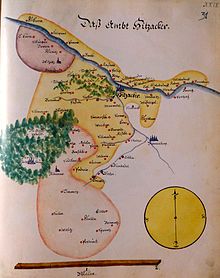Office Hitzacker
The Hitzacker Office was a historical administrative area of the Principality of Lüneburg and the Kingdom of Hanover .
history
The center of the official district was Hitzacker Castle, first mentioned in 1162, which was occupied by Guelph ministers under Heinrich the Lion . The base, which is important for the collection of the Elbe customs, had to be handed over to the Ascanians by Otto the child in 1229 , but in the second half of the 14th century it was again occupied by Guelph bailiffs or bailiffs. In the 15th and 16th centuries, the castle and office were mostly pledged to the von Bülow . In the middle of the 16th century the administration was with the bailiff von Dannenberg . In 1591 the office was incorporated into the Principality of Dannenberg. In 1635 it was temporarily administered from Wolfenbüttel. In 1671 it fell back to the Lüneburg dukes.
The Vogtei Hitzacker is mentioned for the first time as a unified administrative district in the treasury register of 1450 and at that time comprised 41 localities. In 1717, Hitzacker, now known as the Hitzacker Office , consisted of 51 villages. These were divided into the Überelbischen villages (9 localities), the Marschdörfer (4 localities) and the Geestdörfer (38 localities). For the organization of the sovereign services, the office was divided into cloths, each of which included three to seven places. The exact composition and names of the cloths changed again and again. Within the sovereign boundaries of the Bailiwick, there were still twelve villages of the Dannenberg office and one village of the Wustrow office in the 18th century.
After 1844, the previously free city of Hitzacker was incorporated into the office. With the separation of justice and administration (1852) the village Redemoißel came to the office of Clenze and Bellahn , Fließau and Tripkau to the office of Dannenberg. At the same time, the communities of Braasche, Karwitz, Lenzen, Nausen, Quarstedt, Sammatz, Schmardau, Schmessau, Timmeitz and Zernien, which previously formed an enclave of Dannenberg, were reclassified from Dannenberg to Hitzacker. The village of Prepow was reclassified from the Lüchow Office to the Hitzacker Office. In 1859 the office of Hitzacker was canceled. The communities on the left Elbe came to the Neuhaus Office , the right Elbe to the Dannenberg Office.
scope
When it was abolished in 1859, the Hitzacker Office comprised the following communities:
Bailiffs
- 18th century: Johann Caspar Tormin
- 1814–1827: Carl Otto von Plato, Drost
- 1828–1830: vacant
- (1831) 1833–1843: Anton August Cropp, bailiff
- 1844–1848: Georg Dietrich Wilhelm von Reiche, bailiff
- 1849–1858: Friedrich Julius Georg von dem Knesebeck, member of the government
literature
- Iselin Gundermann , Walther Hubatsch : Outline of the German administrative history 1815-1945 . Row A: Prussia, Volume 10: Hanover. Marburg (Lahn) 1981.
- Manfred Hamann : Overview of the holdings of the Lower Saxony Main State Archives in Hanover. Third volume: Central and subordinate authorities in the Landdrostei and administrative districts of Hanover, Hildesheim and Lüneburg until 1945. Göttingen 1983, pp. 233–239.
- Martin Krieg: The origin and development of the administrative districts in the former principality of Lüneburg . Goettingen 1922.
